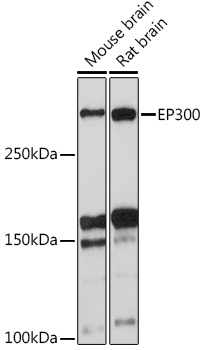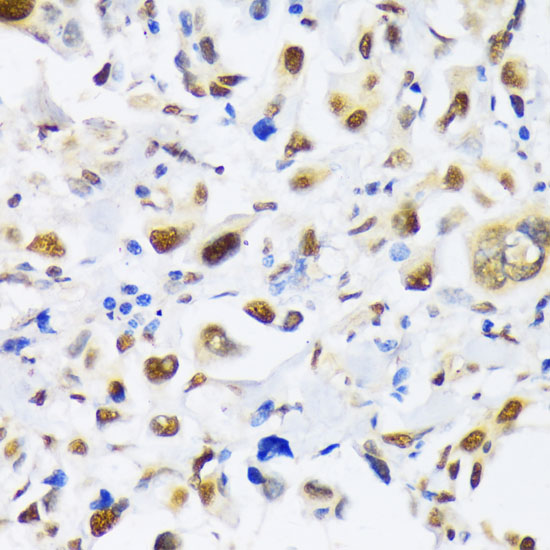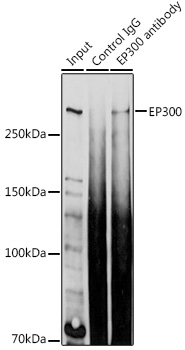Anti-EP300 Antibody (CAB13016)
- SKU:
- CAB13016
- Product type:
- Antibody
- Reactivity:
- Human
- Reactivity:
- Mouse
- Reactivity:
- Rat
- Host Species:
- Rabbit
- Isotype:
- IgG
- Antibody Type:
- Polyclonal Antibody
- Research Area:
- Cell Biology
Description
| 抗体名: | Anti-EP300 Antibody |
| 抗体コード: | CAB13016 |
| 抗体サイズ: | 20uL, 50uL, 100uL |
| 申し込み: | WB IHC IF IP |
| 反応性: | Human, Mouse, Rat |
| 宿主種: | Rabbit |
| 免疫原: | Recombinant fusion protein containing a sequence corresponding to amino acids 1-270 of human EP300 (NP_001420.2). |
| 申し込み: | WB IHC IF IP |
| 推奨希釈: | WB 1:500 - 1:2000 IHC 1:50 - 1:200 IF 1:50 - 1:200 IP 1:50 - 1:200 |
| 反応性: | Human, Mouse, Rat |
| ポジティブサンプル: | Mouse brain, Rat brain |
| 免疫原: | Recombinant fusion protein containing a sequence corresponding to amino acids 1-270 of human EP300 (NP_001420.2). |
| 精製方法: | Affinity purification |
| ストレージバッファ: | Store at -20'C. Avoid freeze / thaw cycles. Buffer: PBS with 0.02% sodium azide, 50% glycerol, pH7.3. |
| アイソタイプ: | IgG |
| 順序: | MAEN VVEP GPPS AKRP KLSS PALS ASAS DGTD FGSL FDLE HDLP DELI NSTE LGLT NGGD INQL QTSL GMVQ DAAS KHKQ LSEL LRSG SSPN LNMG VGGP GQVM ASQA QQSS PGLG LINS MVKS PMTQ AGLT SPNM GMGT SGPN QGPT QSTG MMNS PVNQ PAMG MNTG MNAG MNPG MLAA GNGQ GIMP NQVM NGSI GAGR GRQN MQYP NPGM GSAG NLLT EPLQ QGSP QMGG QTGL RGPQ PLKM GMMN NPNP YGSP YTQN PGQQ IGAS GL |
| 遺伝子ID: | 2033 |
| Uniprot: | Q09472 |
| セルラーロケーション: | Cytoplasm, Nucleus |
| 計算された分子量: | 264kDa |
| 観察された分子量: | 264KDa |
| 同義語: | EP300, KAT3B, RSTS2, p300 |
| バックグラウンド: | This gene encodes the adenovirus E1A-associated cellular p300 transcriptional co-activator protein. It functions as histone acetyltransferase that regulates transcription via chromatin remodeling and is important in the processes of cell proliferation and differentiation. It mediates cAMP-gene regulation by binding specifically to phosphorylated CREB protein. This gene has also been identified as a co-activator of HIF1A (hypoxia-inducible factor 1 alpha), and thus plays a role in the stimulation of hypoxia-induced genes such as VEGF. Defects in this gene are a cause of Rubinstein-Taybi syndrome and may also play a role in epithelial cancer. |
| UniProt Protein Function: | p300: a histone acetyltransferase and transcriptional co-activator that regulates transcription via chromatin remodeling. Acetylates all four core histones in nucleosomes. Related to CPB (CREB-binding protein), and like CPB can stimulate transcription through activation of CREB. Specifically inhibited by the adenovirus oncoprotein E1A. A co-activator of HIF1A (hypoxia-inducible factor 1 alpha), and thus plays a role in the stimulation of hypoxia-induced genes such as VEGF. Mediates cAMP-gene regulation by binding specifically to phosphorylated CREB protein. Methylated at R580 and R604 in the KIX domain by CARM1, which blocks association with CREB, inhibits CREB signaling and activates the apoptotic response. Also methylated at R2142 by CARM1, which impairs interaction with NCoA2. |
| UniProt Protein Details: | Protein type:Transcription, coactivator/corepressor; Motility/polarity/chemotaxis; EC 2.3.1.48; Nuclear receptor co-regulator; Acetyltransferase Chromosomal Location of Human Ortholog: 22q13.2 Cellular Component: cytoplasm; histone acetyltransferase complex; nucleoplasm; nucleus; transcription factor complex Molecular Function:acetyltransferase activity; androgen receptor binding; beta-catenin binding; chromatin binding; chromatin DNA binding; damaged DNA binding; DNA binding; histone acetyltransferase activity; lysine N-acetyltransferase activity; nuclear hormone receptor binding; p53 binding; protein binding; protein C-terminus binding; transcription activator binding; transcription coactivator activity; transcription factor binding; transferase activity, transferring acyl groups; zinc ion binding Biological Process: apoptosis; B cell differentiation; circadian rhythm; DNA damage response, signal transduction by p53 class mediator resulting in induction of apoptosis; DNA repair; establishment and/or maintenance of chromatin architecture; fat cell differentiation; G2/M transition of mitotic cell cycle; gene expression; heart development; innate immune response; internal peptidyl-lysine acetylation; internal protein amino acid acetylation; lung development; mitotic cell cycle; N-terminal peptidyl-lysine acetylation; negative regulation of transcription from RNA polymerase II promoter; nervous system development; Notch signaling pathway; nucleotide-excision repair; organ morphogenesis; platelet formation; positive regulation of gene expression, epigenetic; positive regulation of interferon type I production; positive regulation of protein binding; positive regulation of transcription factor activity; positive regulation of transcription from RNA polymerase II promoter; positive regulation of transcription of target genes involved in unfolded protein response; protein amino acid acetylation; protein stabilization; regulation of cell cycle; regulation of gene expression, epigenetic; regulation of transcription, DNA-dependent; response to estrogen stimulus; response to hypoxia; skeletal muscle development; somitogenesis; stimulatory C-type lectin receptor signaling pathway; transcription from RNA polymerase II promoter; transcription-coupled nucleotide-excision repair; viral reproduction Disease: Colorectal Cancer; Rubinstein-taybi Syndrome 1; Rubinstein-taybi Syndrome 2 |
| NCBI Summary: | This gene encodes the adenovirus E1A-associated cellular p300 transcriptional co-activator protein. It functions as histone acetyltransferase that regulates transcription via chromatin remodeling and is important in the processes of cell proliferation and differentiation. It mediates cAMP-gene regulation by binding specifically to phosphorylated CREB protein. This gene has also been identified as a co-activator of HIF1A (hypoxia-inducible factor 1 alpha), and thus plays a role in the stimulation of hypoxia-induced genes such as VEGF. Defects in this gene are a cause of Rubinstein-Taybi syndrome and may also play a role in epithelial cancer. [provided by RefSeq, Jul 2008] |
| UniProt Code: | Q09472 |
| NCBI GenInfo Identifier: | 223590203 |
| NCBI Gene ID: | 2033 |
| NCBI Accession: | Q09472.2 |
| UniProt Secondary Accession: | Q09472,B1AKC2, |
| UniProt Related Accession: | Q09472 |
| Molecular Weight: | 264,161 Da |
| NCBI Full Name: | Histone acetyltransferase p300 |
| NCBI Synonym Full Names: | E1A binding protein p300 |
| NCBI Official Symbol: | EP300 |
| NCBI Official Synonym Symbols: | p300; KAT3B; RSTS2 |
| NCBI Protein Information: | histone acetyltransferase p300 |
| UniProt Protein Name: | Histone acetyltransferase p300 |
| UniProt Synonym Protein Names: | E1A-associated protein p300 |
| Protein Family: | Histone acetyltransferase |
| UniProt Gene Name: | EP300 |
| UniProt Entry Name: | EP300_HUMAN |




